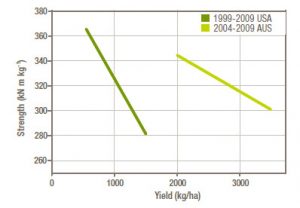High yields vs. fiber quality – The ultimate challenge of cotton growers
2019
Researchers aim to improve upland cotton breeding efficiency that overcomes negative associations Cotton taxonomy has been widely studied due its… Read more
Researchers aim to improve upland cotton breeding efficiency that overcomes negative associations
Cotton taxonomy has been widely studied due its industrial importance; 50 or more Gossypium species are believed to have appeared 10-20 million years ago in three centers of origin – Australia, Africa-Arabia and Central America.
The cultivated varieties of cotton originated some 5,000 years ago from four species that – due to their ability to produce fibers that are long enough to be spun into yarn for textiles – have been grown commercially. The four species are G. hirsutum (upland cotton), G. barbadense (Pima, Egyptian or Sea Island cotton), G. arboreum (desi cotton), and G. herbaceum (Levant or Arabian cotton). Among the four, G. hirsutum delivers the highest fiber yield and is the most adaptable, making it by far the most popular cotton species with 95% of all global cotton production.
Over the last few years, cotton cultivation worldwide has declined primarily due to high production costs and strong competition for planted areas from crops such as rice, sugar, maize, wheat and soybean. While upland cotton dominates global cotton production due to its high yield, its fiber quality is undesirable. As a result, one of the goals of global cotton breeding programs is to improve its cultivars. However, this remains a difficult challenge for upland cotton breeders given that there is a typical tradeoff between many important fiber properties and lint yield.
The most significant tradeoff of this kind occurs between yield and fiber strength and length, two traits that play an important role in optimizing textile processing efficiency and producing a high-quality end product. It should be noted, however, that the extent of the tradeoff is population-specific, with each genotype not always responding to selection pressure in the same way. As such, varied performances are acceptable in different environments and under different conditions (e.g. climate, irrigation/drought, soil, pests, and diseases).Since variety selection is probably one of the most important decisions affecting a cotton crop’s success, it is essential to select the right cotton variety in a specific geography to ensure optimal performance.

One of the studies that shows the tradeoff between yield and fiber quality is from the article
“Negative associations still exist between yield and fiber quality in cotton breeding programs in Australia and USA”. The graph above is taken from that source, and represents the regression of yield compared to fiber strength over a number of years in Australia and the US.
In the study, the authors claim that, according to the Australian data, the frequency of lines with greater-than-average yield was 7.9% for length, 9.3% for strength, and 1.1% for length and strength. These findings further emphasize the negative associations with yield, and provide a strong indication that larger breeding population sizes may be required to identify desired combinations of fiber properties with yield.
The authors conclude that “the literature is not clear on reasons for these associations, and precise study of those reasons is required to develop strategies for breaking the associations.”
Meanwhile, given the ongoing development of biotech approaches, cotton breeders can combine conventional breeding with new molecular biology-based techniques. Since lint yield and fiber quality properties are controlled by many genes – each one inducing only a small effect and being influenced by ambient conditions – it is very challenging to make improvements in this area.
Researchers worldwide, however, continue to gain more knowledge and develop smart technologies for cotton breeders so that they can create new cotton varieties that provide high yields and high fiber quality more efficiently.
- “Barriers to Breeding High Fiber Quality Cotton Varieties”
F.M.Bourland, University of Arkansas, Northeast Research & Extension Center Keiser, Arkansas, USA,
Don C. Jones Agricultural Research, Cotton Incorporated Cary, North Carolina, USA - “Cotton Breeding for Fiber Quality Improvement”
Greg Constable, Danny Llewellyn, Sally Ann Walford, and Jenny D. Clement
Agriculture Flagship of Plant Industry, CSIRO, Narrabri, NSW, Australia
Agriculture Flagship of Plant Industry, CSIRO, Acton, ACT, Australia - “Negative associations still exist between yield and fibre quality in cotton breeding programs in Australia and USA”
By J.D. Clement∗, G.A. Constable, W.N. Stiller, S.M. Liu
Field Crops Research, 128 (2012) - Selection and Response of Yield and Fiber Traits in Upland Cotton
Haley Danielle Kennedy, Masters’ thesis submitted to the Office of Graduate and Professional Studies of Texas A&M University





